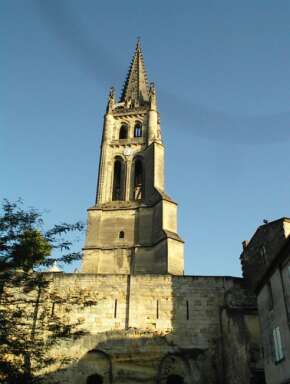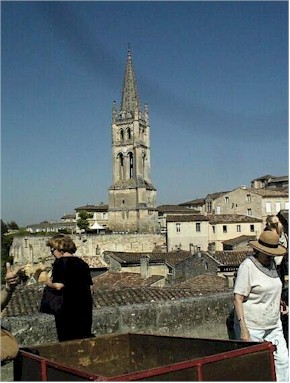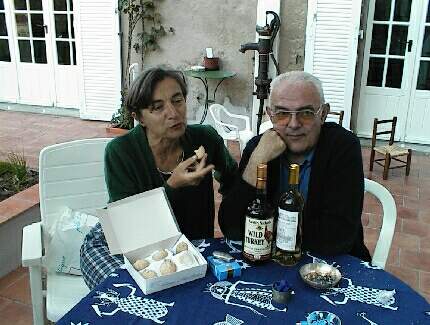 WVU-V!
WVU-V!

 WVU-V!
WVU-V!

Some Sunny Day!!!
June 19, 2000

(The church tower above Saint Emilion's hermitage,
June 19, 2000)
| The morning begins for the WVU-Vendéens with a pleasant breakfast on the terrace of our hotel, the Logis des Remparts in the medieval village of Saint-Emilion. Fresh summer cherries, apples, kiwi fruit, yogurt, a variety of pastries and breads with butter, honey, or jam are all on the platter for us this morning. Fresh fruit certainly fits the bill today, since the forecast calls for bright sun and high temperatures not only here in the southwest, but all across France. |
| The site of Saint-Emilion exists as a village from the early middle ages. Our Mountaineers here prepare to enter the town through the north wall that once protected Saint-Emilion's inhabitants from enemies both foreign and domestic. |
| A wall through the narrow cobblestone streets brings us to this plaza overlooking the lower village. To the right we see the King's Tower. Which king is a bit of a question, since this area was long disputed between the kings of France and of England. My guidebook says this tower is attributed to by either Henry III Plantagenêt, king of England and son of Richard the Lion-Heart's brother King John, or Louis VIII of France, one of the great Capetian monarchs and father of the legendary crusader Saint Louis or Louis IX. |
 As
we've said earlier in these pages, the western lands of today's France
were largely independent from the courts of Paris until relatively modern
times. Eleanor of Aquitaine was certainly the key figure in this
situation. Only two months after her divorce from King Louis VII of
France, she married Henri Plantagenêt, count of Anjou and soon-to-be king
of England. Her marriage with Henri was hardly more harmonious, as
one sees in the Academy Award winning film "The Lion in Winter"
(1968). As
we've said earlier in these pages, the western lands of today's France
were largely independent from the courts of Paris until relatively modern
times. Eleanor of Aquitaine was certainly the key figure in this
situation. Only two months after her divorce from King Louis VII of
France, she married Henri Plantagenêt, count of Anjou and soon-to-be king
of England. Her marriage with Henri was hardly more harmonious, as
one sees in the Academy Award winning film "The Lion in Winter"
(1968).
Upon Henry's death, Eleanor was largely responsible for assuring her son Richard the Lion-Heart's ascendance. Richard's death brought his brother John to "power". John was in a precarious position, trying to assert his authority over vast lands whose loyalties were dubious or nonexistent. He adopted the newly conceived idea of the "charter" by which he accepted conditions of rule in order the gain the allegiance of his subjects. This village of Saint-Emilion was among the first to gain a charter from John in the year 1199, the very first year of his reign (France was abuzz last year with festival in memory of the death of Richard the Lion-Heart, but little mention was made of the ascension of poor king John). Soon things were out of hand and John was faced with masses of powerful subjects asking for conditions to their loyalty. It was a matter of economy for John that he finally accepted a charter covering several different constituencies back in the British Isles. In Latin he called this massive contract the "Magna Carta," or the Grand Charter, which he signed in 1215. Thus began the long, slippery path to what we today call "constitutional government." |
| The "Porte Brunet" is one of the original doors to the city. Those of us who have ventured beyond expose ourselves to attack from any enemy that might lie in wait. Fortunately, things look pretty calm today. The visibility is good and the fearless Mountaineers you see to the right would certainly make fast fodder of any feckless foe. |
| The lands around Saint-Emilion are prime for the growth
of the grape vine. Each little farm we see from this perspective
produces its own label of the delicate red Bordeaux wine that carries this
village's name.
Armed with my digital camera today, I kept watch from within the walls of the city. Our group, however, has divided in half, one party venturing forth to the vineyard of Cadet-Piola, just a few hundred yards beyond the northern wall by which we entered. From the news I've gotten the visit to he vineyard was a truly enlightening interlude, lead by the charming and knowledgeable Amélie Jabiol who runs the vineyard with her father Alain Jabiol. |
| As noon approaches, the sun begins to bake the cobblestones to rather high temperatures. Our schedule permits only an informal lunch today. I feel fortunate to find a tea shop with a shaded arch that provides relief from the mid-day heat. It was a very pleasant pause for Jennifer Martin, Bill Davis, myself, and Senan Mashat. Mr. Davis knows France and French quite well, he shared some of his previous adventures in this lovely land with us relative newcomers. |
| After a quick lunch we board the Vendée-Mobile and head back into Bordeaux. We make a quick stop at the ship and a few go aboard to take respite from the adventures of the morning. |
| We then begin tour of the city with our guide, Monsieur Simone who is a true lover of every aspect of his city's art, architecture and history. |
| Here we see the Fountain of the Girondins, a monument to the values of the French Revolution -- freedom, civic responsibility, equality, justice, prosperity, and of course fraternity -- each represented by one of the figures or details of this attempt at political persuasion. |
| Many of the most treasured examples of Bordeaux's architecture date from the 18th century and much of it is now in the midst of a restoration project that will last many years. |
| Like most cities dating from medieval times, Bordeaux was once walled on all sides. Here we see the most famous door to the city, the door of the Grosse Cloche, or Big Bell. |
|
| Bordeaux's cathedral is the site of the ill-fated marriage of Eleanor of Aquitaine to King Louis VII of France in the year 1137. Young Louis' father and the venerable Abbot Suger had launched a major campaign to strengthen the image and power of the French monarchy. The first Gothic church in the world, Saint-Denis which we visited earlier, was their work, as was the pursuit of the grand Crusades to take Jerusalem back from the forces of the new religion called Islam. Eleanor would in fact participate in two crusades herself, the second with good king Louis VII and the third with her son Richard the Lion-Heart. Nearly a century later her great grandson, Saint Louis (Louis IX of France) would lead the last two crusades and die of the plague in Tunisia. |
| As our few hours in Bordeaux draw to an end, we say good-bye to the Gold and Blue Travelers and head back to the Vendée-Mobile, parked in the shadow of the majestic Crystal Symphony. |
| As we board the Vendée-Mobile we salute the last of our
friends from the Gold and Blue. Ironically, Dick Smith was absent
from his table when I took my pictures yesterday at Cazeneuve. It is
thus with mixed satisfaction and pleasure that I was able to make this
snapshot of one of our truest Mountaineers. Look carefully in the
very center of this picture. In the upper deck there is a dark band
running near the top of the ship. The small white figure you see in
the middle is Mr. Smith!!!!
Not the least of the ironies here is that he is holding a camera with a 14 power zoom lens. My modest unit is great for close shots and for interior spaces, but as you see, it has no zoom. Farewell, Mr. Smith and bon voyage! We hope to see you closer up back in the land the Mountaineer.... |
| Having bid goodbye to the Gold and Blue Travelers, we board the Vendée-Mobile for our ride back up the coast to Les Sables d'Olonne. By late afternoon the heat has reached its peak, so we take a pause for refreshment along the way. It's surely no coincidence that the pop-sickle picked out by Cindy Howley and Katie McMullen is true BLUE. The gold is of course in Katie's hair and in both their hearts... |
 Upon
our return to Les Sables our first stop is at the home Loïc and
Jacqueline Le Bourhis, who have both been instrumental in making the last
two days possible. We deliver greetings from their friends Messieurs
Ritz and de Sabran who were so hospitable to us on Sunday. They were
especially pleased to hear that despite a few traffic delays things went
well for the Gold and Blue Travelers and for our young Vendéens. Upon
our return to Les Sables our first stop is at the home Loïc and
Jacqueline Le Bourhis, who have both been instrumental in making the last
two days possible. We deliver greetings from their friends Messieurs
Ritz and de Sabran who were so hospitable to us on Sunday. They were
especially pleased to hear that despite a few traffic delays things went
well for the Gold and Blue Travelers and for our young Vendéens.
I should add here that this visit was a real discovery for our students. Their eyes were opened not only to some of the beauties of France, but also to the common bond that links them to a new set of friends they would not likely have met in an ordinary classroom. Students their age do not often contemplate the importance that WVU will have for them across their lifetimes. They also don't often think of the broad range of elements that make a school like WVU possible. This meeting with the Hardesty's and with the Gold and Blue Travelers was a wonderful revelation for us all. |
| Since we left bright and early Sunday morning, we left
our youngest one, Lucie, on Saturday with her uncle and aunt Antoine and
Géraldine Crêtaux, two other people to whom we owe a great debt.
That meant of course that, as for many on this trip, Lucie and her father
could not be together on Father's day this year. My heart melted
when she presented me with the custom-labeled wine bottle that she had
made as her craft project in her kindergarten here in Les Sables.
It's been an unforgettable weekend for all of us, but it's also great to be back "home". Of course we Vendéens still have a few weeks before getting back to West Virginia, but the Gold and Blue Travelers will likely be there in a few days. We look forward to the next fine, sunny day when we will see you all again back on the other side of the pond! |
|
Stay tuned to WVU-V!
Back to the Calendar
Comments to: mlasting@wvu.edu